In addition to the Radeon RX 7900 XTX that I already covered today, AMD is also launching its brother the Radeon RX 79000 XT and we have had that card in the office as well. This is also an RDNA 3 architecture card and it shares the same Navi 31 GPU as the 7900 XTX but with a few changes. So today I’m going to check out what those changes are and then we can see what the AMDs reference card looks like and how it differs from the 7900 XTX then see how it performs in our test suite as well. So let’s dive in!
Product Name: AMD Radeon RX 7900 XT
Review Sample Provided by: AMD
Written by: Wes Compton
Amazon Affiliate Link: HERE
RNDA 3
So what sets the new Radeon RX 7900 XTX and 7900 XT apart from the 6000 series cards? Well at their core, this is a new architecture RDNA 3. AMD has taken their experience on the CPU side to bring their chiplet design into their GPU architecture. This means that the GPU uses multiple dies, not just everything on one die, and this offers a few advantages. It offers more flexibility in their product stack and more importantly, it means that they can combine different manufacturing processes. So the GCD or graphics compute die is made on the new 5nm process but the memory cache die or MCD is made on the larger 6nm process. This puts their GDDR6 interface and 2nd generation infinity cache on the more mature process and the GPU itself on the newer smaller 5nm process for better performance per watt. This design can help keep costs down as well. You can see the smaller process at work in the specs with the 7900’s having 57.7 billion transistors to the 6950 XT’s 26.8 billion transistors but with the 300 mm GCD and 220 mm² MCD vs the 520 mm² of the 6950 XT.
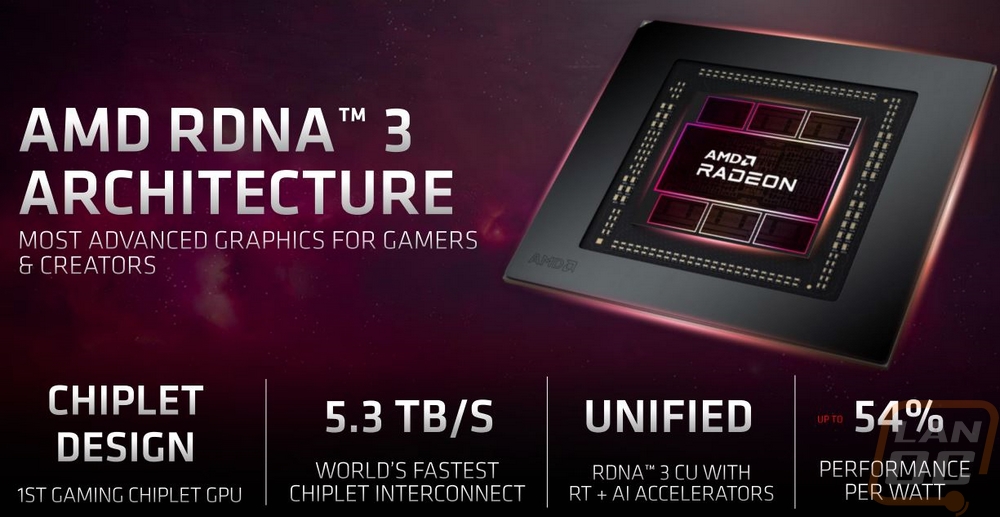
AMD changed up their infinity cache as well this time around which can be seen in the specification listing down below when we compare the 6950 XT to either of the 7900 models. The 6950 XT had 128MB of infinity cache with a 256-bit memory bus and 18 GB of GDDR6 memory. The 7900 XT on the other hand has 80MB of the 2ng gen infinity cache and a larger 320-bit memory bus, the 7900 XTX has a little more at 96 MB of infinity cache and a larger 384-bit memory bus with both having the same 20GB of GDDR6 memory. But those changes take the memory bandwidth from 1793.5 GB/s on the 6950 XT to 2912 GB/s on the 7900 XT and 3494.4 GB/s on the 7900 XTX, a big improvement while using less cache.
The new architecture also introduces new AL accelerator cores similar to Nvidia’s Tensor cores which the 7900 XTX has 192 AI cores and the 7900 XT has 168 AI cores. These will help with FidelityFX performance and open up more options for AMD there in the future. They have also improved the ray tracing cores with a new Gen 2 design. Those match with the compute cores 1 for 1 so the 7900 XTX has 96 of each and the 7900 XT has 84 which both are an improvement over the 9650 XT which had 80 each with the older gen 1 RT cores. As far as clock speeds, AMD has stayed in the same range as the 6950 XT before which had a game clock speed of 2100 MHz and would run up to 2310 MHz for boost clock. The 7900 XT is a little lower on the game clock at 2000 MHz but higher on the boost clock at 2400 MHz and the 7900 XTX is higher on both with the game clock at 2300 MHz and the boost up to 2500 MHz.
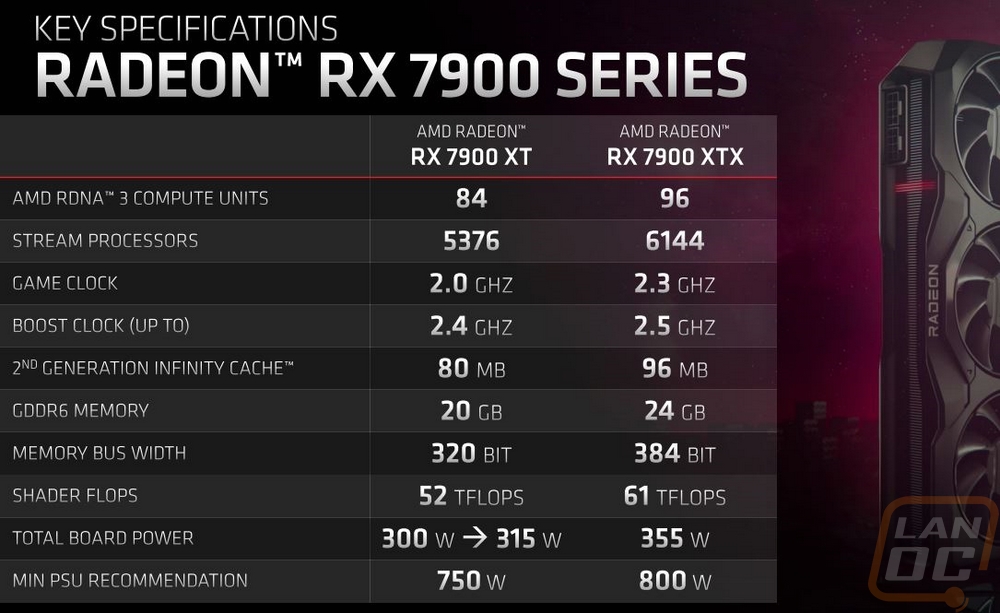
|
Specifications |
RX 7900 XTX |
RX 7900 XT |
RX 6950 XT |
|
Architecture |
RDNA 3 |
RDNA 3 |
RDNA 2 |
|
Manufacturing Process |
5nm GCD + 6 nm MCD |
5nm GCD + 6 nm MCD |
7nm |
|
Transistor Count |
57.7 billion |
57.7 billion |
26.8 billion |
|
Die Size |
300 mm² GCD 220mm² MCD |
300 mm² GCD 220mm² MCD |
520 mm² |
|
Compute Units |
96 |
84 |
80 |
|
Ray Accelerators |
96 |
84 |
80 |
|
AI Accelerators |
192 |
168 |
- |
|
Stream Processors |
6144 |
5376 |
5120 |
|
Game GPU Clock |
2300 MHz |
2000 MHz |
2100 MHz |
|
Boost GPU Clock |
Up to 2500 MHz |
Up to 2400 MHz |
Up to 2310 MHz |
|
Peak Single Precision Performance |
Up to 61 TFLOPS |
Up to 52 TFLOPS |
Up to 23.65 TFLOPS |
|
Peak Half Precision Performance |
Up to 123 TFLOPS |
Up to 103 TFLOPS |
Up to 47.31 TFLOPS |
|
Peak Texture Fill-Rate |
Up to 960 GT/s |
Up to 810 GT/s |
Up to 739.2 GT/s |
|
ROPs |
192 |
192 |
128 |
|
Peak Texture Fill-Rate |
Up to 480 GP/s |
Up to 460 GP/s |
Up to 295.7 GP/s |
|
AMD Infinity Cache |
96 MB |
80 MB |
128 MB |
|
Memory |
24GB GDDR6 |
20GB GDDR6 |
16GB GDDR6 |
|
Effective Memory bandwidth w/AMD Infinity Cache |
Up to 3500 GB/s |
Up to 2900 GB/s |
Up to 1793.5 GB/s |
|
Memory Bus Interface |
384-bit |
320-bit |
256-bit |
|
PCIe Interface |
PCIe 4.0 x16 |
PCIe 4.0 x16 |
PCIe 4.0 x16 |
|
Board Power |
355W |
315W |
335W |
AMD took a few different stabs at Nvidia in their presentation on the new cards. They put together a direct comparison showing how both cards are significantly smaller than the RTX 4080 which will help a lot when it comes to fitment. They also point out that their cards aren’t using the new 12VHPWR plug which has caused some people issues.
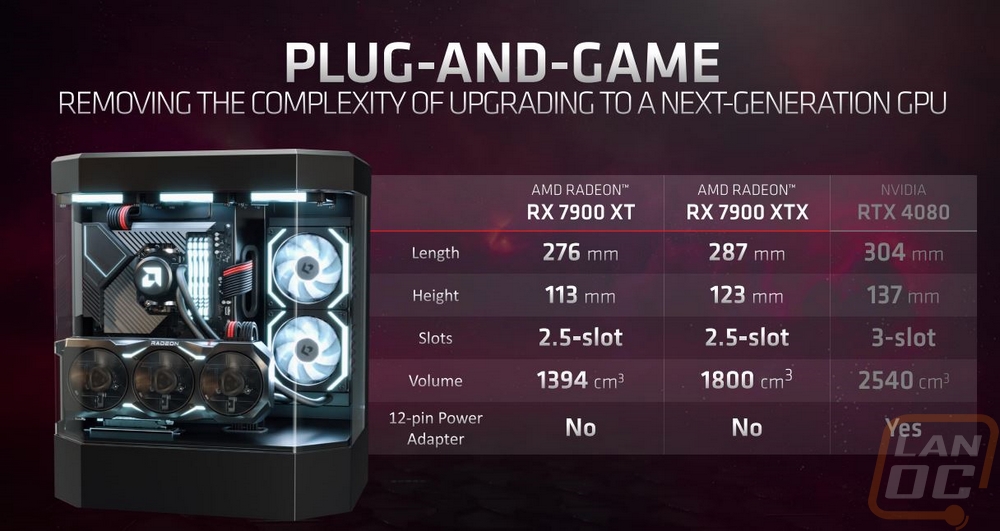
Another jab at Nvidia comes with their inclusion of what they call AMD Radiance Display Engine which is what brings the support for DisplayPort 2.1 connections on the cards. This opens up long-term support for much higher refresh rates. At 1440p for example the connection is capable of 900 Hz where 480 Hz is the limit for DP 1.4. This bandwidth becomes more important at higher resolutions like 4k which is capped at 240 Hz with DP 1.4 but can do 480 Hz with DP 2.1. Then at 8K DP 1.4 is limited to 60 Hz but DP 2.1 can do 165 Hz.
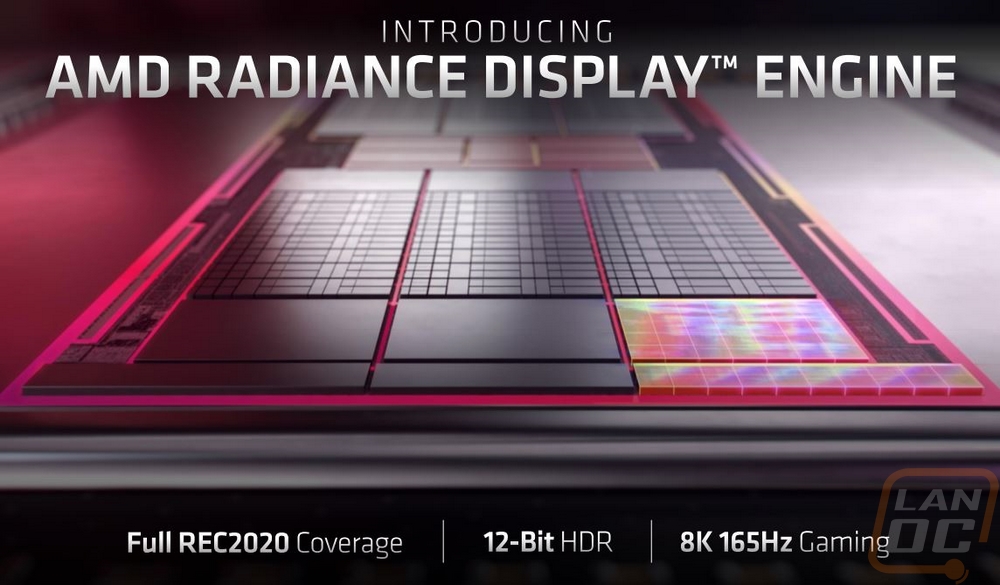
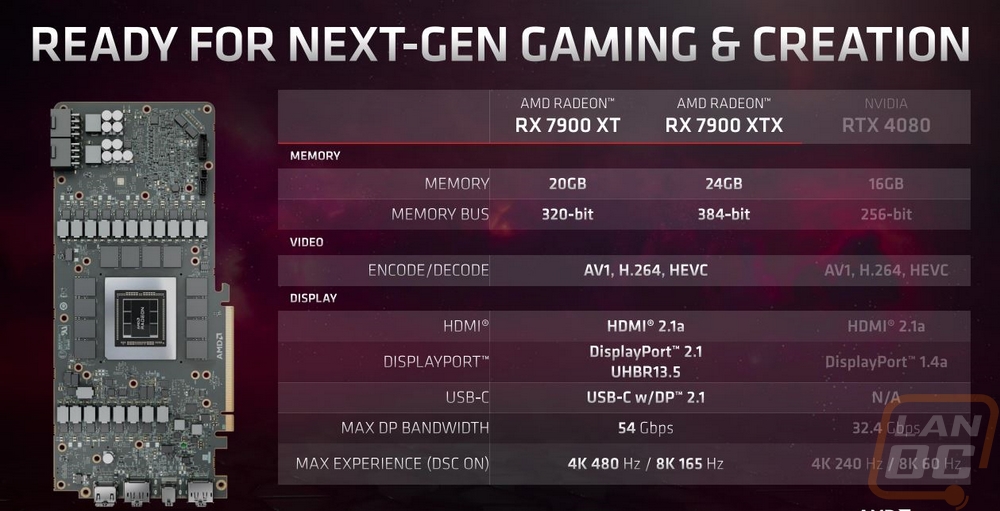
They also highlighted the adoption rate of FidelityFX Super Resolution and Super Resolution 2 which is available or upcoming in 226 games after one year of availability.
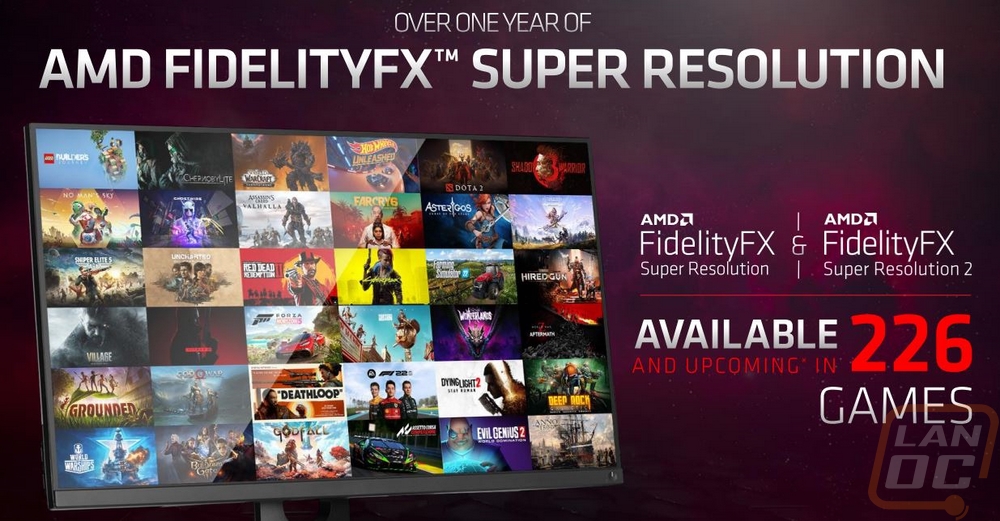
The new cards also have AV1 support which is going to be an important feature when consuming video content online and especially for streamers as it can open up higher-quality video streaming at lower bandwidth. AMD has included support for two simultaneous encode or decode streams similar to what the 4090 and 4080 can do.
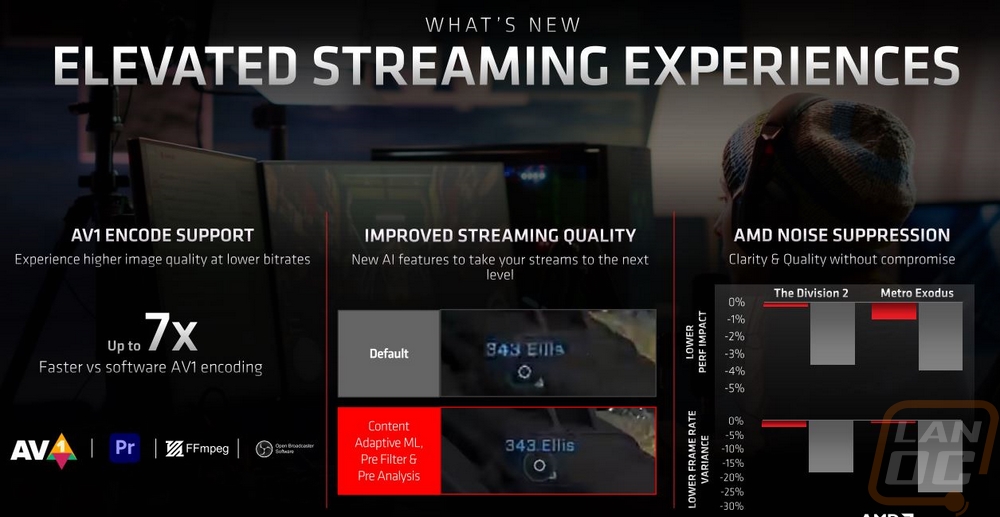
The other big feature is of course AMDs pricing. They have the base suggested price for the 7900 XT at $899 and the 7900 XTX at $999 which is an improvement over the RTX 4080’s Founders Edition price of $1199. Once I get into testing we will have to see how they compare performance-wise, but AMD has themselves positioned well here.
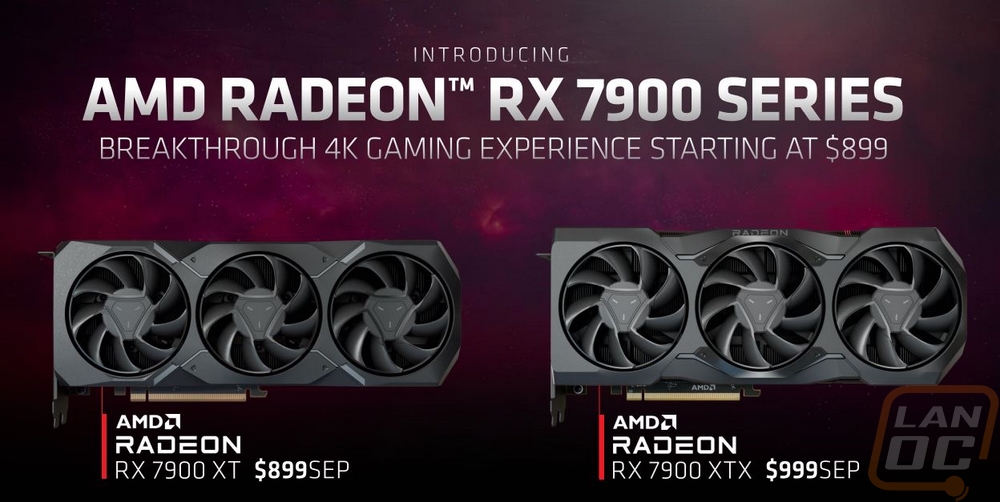
Before getting into testing I did also run GPUz which I normally do to double-check clock speeds but as of writing this GPUz hasn’t added support for the new GPUs yet and the clock speed readings are all over the place. The BIOS revision also isn’t shown but we can at least document that I am testing with the prerelease press driver which is Adrenalin 22.40.00.57.


